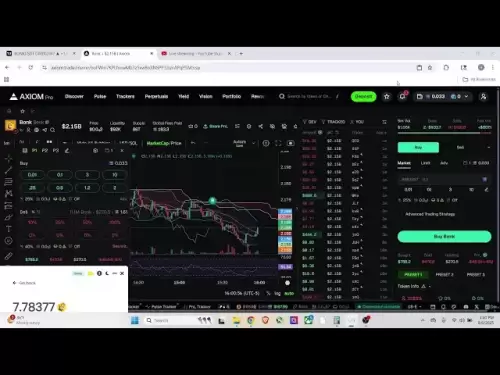-
 Bitcoin
Bitcoin $116700
2.16% -
 Ethereum
Ethereum $3830
5.76% -
 XRP
XRP $3.082
4.56% -
 Tether USDt
Tether USDt $1.000
0.04% -
 BNB
BNB $777.8
1.96% -
 Solana
Solana $173.2
5.46% -
 USDC
USDC $0.0000
0.02% -
 Dogecoin
Dogecoin $0.2146
6.85% -
 TRON
TRON $0.3384
0.92% -
 Cardano
Cardano $0.7676
5.51% -
 Hyperliquid
Hyperliquid $39.28
4.90% -
 Sui
Sui $3.723
9.07% -
 Stellar
Stellar $0.4164
6.32% -
 Chainlink
Chainlink $17.36
5.78% -
 Bitcoin Cash
Bitcoin Cash $580.9
3.62% -
 Hedera
Hedera $0.2544
5.50% -
 Ethena USDe
Ethena USDe $1.001
0.02% -
 Avalanche
Avalanche $22.81
3.81% -
 Litecoin
Litecoin $120.8
3.60% -
 UNUS SED LEO
UNUS SED LEO $8.956
-0.35% -
 Toncoin
Toncoin $3.311
4.28% -
 Shiba Inu
Shiba Inu $0.00001266
4.15% -
 Uniswap
Uniswap $10.10
5.97% -
 Polkadot
Polkadot $3.786
4.80% -
 Dai
Dai $1.000
0.01% -
 Monero
Monero $280.4
-4.02% -
 Bitget Token
Bitget Token $4.405
1.69% -
 Cronos
Cronos $0.1480
5.13% -
 Pepe
Pepe $0.00001087
5.67% -
 Ethena
Ethena $0.6348
11.62%
Should SOL sell when its RSI indicator is overbought?
When SOL's RSI is overbought, consider selling a portion, but also evaluate other indicators, market sentiment, and fundamentals before deciding.
Apr 20, 2025 at 07:49 am

When considering whether to sell Solana (SOL) when its Relative Strength Index (RSI) indicator is overbought, it's essential to understand the RSI and its implications within the context of cryptocurrency trading. The RSI is a momentum oscillator that measures the speed and change of price movements on a scale of 0 to 100. Traditionally, an RSI value above 70 is considered overbought, suggesting that the asset may be due for a price correction. However, the decision to sell SOL based solely on an overbought RSI should not be made without considering other factors and market conditions.
Understanding the RSI Indicator
The Relative Strength Index (RSI) is a popular technical indicator used by traders to assess the momentum of price changes. It compares the magnitude of recent gains to recent losses to determine overbought or oversold conditions. An RSI value above 70 indicates that an asset might be overbought, while a value below 30 suggests it might be oversold. In the context of SOL, an RSI reading above 70 might signal that the cryptocurrency has experienced significant upward momentum and could be due for a pullback.
The Overbought Condition and SOL
When SOL's RSI indicates an overbought condition, it suggests that the cryptocurrency may have risen too quickly and could be ripe for a correction. However, an overbought RSI does not guarantee a price drop. The cryptocurrency market is known for its volatility, and SOL might continue to rise despite being in overbought territory. Traders should consider other technical indicators, market sentiment, and fundamental analysis before deciding to sell based on the RSI alone.
Other Technical Indicators to Consider
While the RSI is a valuable tool, it is not the only indicator traders should use when analyzing SOL. Other technical indicators that can provide additional insights include:
- Moving Averages: These can help identify trends and potential reversal points. For instance, if SOL's price is above its 50-day moving average but approaching its 200-day moving average, it might indicate a potential resistance level.
- MACD (Moving Average Convergence Divergence): This indicator can signal changes in momentum and potential trend reversals. A bearish crossover of the MACD line below the signal line could reinforce the decision to sell.
- Bollinger Bands: These can help identify volatility and potential overbought or oversold conditions. If SOL's price is touching the upper Bollinger Band, it might be a sign that the cryptocurrency is overbought.
Market Sentiment and Fundamental Analysis
In addition to technical indicators, traders should consider market sentiment and fundamental analysis when deciding whether to sell SOL. Market sentiment can be gauged through social media, news, and trading volumes. If there is positive news or high trading volumes supporting SOL's price, it might be less likely to experience a significant correction despite an overbought RSI.
Fundamental analysis involves evaluating the underlying factors that could affect SOL's price, such as developments within the Solana ecosystem, partnerships, and overall adoption of the platform. If these fundamentals are strong, it might be prudent to hold onto SOL even if the RSI is overbought.
Risk Management and Trading Strategy
Effective risk management is crucial when deciding whether to sell SOL based on an overbought RSI. Traders should consider their risk tolerance and investment goals. If the potential for a price correction is too risky, selling a portion of SOL holdings might be a wise decision. However, if the trader is willing to hold through potential volatility, they might choose to keep their positions.
A well-defined trading strategy can also help. For instance, a trader might decide to sell a portion of their SOL holdings when the RSI reaches 70 and then reassess the situation based on other indicators and market conditions. This approach allows for flexibility and can help mitigate risk.
Practical Steps for Using RSI to Make Decisions
Here are some practical steps traders can take when using the RSI to decide whether to sell SOL:
Monitor the RSI: Regularly check the RSI value for SOL on your preferred trading platform or charting tool.
Set Alerts: Set up alerts for when SOL's RSI reaches or exceeds 70, so you can take timely action.
Analyze Other Indicators: Before making a decision, review other technical indicators like moving averages, MACD, and Bollinger Bands to get a more comprehensive view of SOL's momentum and potential price direction.
Evaluate Market Sentiment: Check social media, news outlets, and trading volumes to gauge the overall sentiment towards SOL.
Consider Fundamentals: Review any recent developments, partnerships, or changes in the Solana ecosystem that might impact SOL's long-term value.
Execute the Trade: If all factors suggest a potential price correction, consider selling a portion of your SOL holdings. Ensure you follow proper trading procedures:
- Log into your trading platform.
- Navigate to your SOL holdings.
- Select the amount you wish to sell.
- Confirm the trade and review the transaction details.
- Monitor the trade execution and ensure it completes successfully.
Review and Adjust: After selling, continue to monitor SOL's price and RSI. If the situation changes, be prepared to adjust your strategy accordingly.
Frequently Asked Questions
Q: Can SOL continue to rise even when its RSI is overbought?
A: Yes, SOL can continue to rise even when its RSI is overbought. The cryptocurrency market can remain in overbought conditions for extended periods due to strong bullish sentiment or significant buying pressure. Traders should not rely solely on the RSI but consider other indicators and market conditions.
Q: How often should I check the RSI for SOL?
A: The frequency of checking the RSI for SOL depends on your trading style. Day traders might check the RSI multiple times throughout the day, while swing traders might check it daily or weekly. Setting up alerts can help you stay informed without constantly monitoring the market.
Q: What other indicators can complement the RSI when trading SOL?
A: Other indicators that can complement the RSI include moving averages, MACD, and Bollinger Bands. Moving averages can help identify trends, MACD can signal changes in momentum, and Bollinger Bands can highlight volatility and potential overbought or oversold conditions.
Q: Should I sell all my SOL holdings when the RSI is overbought?
A: Selling all your SOL holdings when the RSI is overbought is not necessarily the best strategy. Consider selling a portion of your holdings to manage risk while retaining some exposure to potential future gains. Always assess other indicators and market conditions before making a decision.
Disclaimer:info@kdj.com
The information provided is not trading advice. kdj.com does not assume any responsibility for any investments made based on the information provided in this article. Cryptocurrencies are highly volatile and it is highly recommended that you invest with caution after thorough research!
If you believe that the content used on this website infringes your copyright, please contact us immediately (info@kdj.com) and we will delete it promptly.
- Ollama Turbo & GPT-OSS: Revolutionizing AI Model Accessibility and Speed
- 2025-08-07 20:29:33
- Bitcoin Ordinals: NFTs Evolving Bitcoin or a Fleeting Fad?
- 2025-08-07 20:29:33
- BlockchainFX, Bitcoin Swift, Crypto Presales: What's the Hype?
- 2025-08-07 19:10:13
- Pepe Dollar (PEPD) vs. SPX6900: The Meme Coin Battle of 2025
- 2025-08-07 19:50:12
- XRP Investment Regret: Are You Missing Out on the Next Big Thing?
- 2025-08-07 19:50:12
- XRPINU: More Than Just a Meme? Roadmap, Liquidity, and the Future of Funny Money
- 2025-08-07 19:56:46
Related knowledge

How to avoid common crypto investment mistakes?
Jul 13,2025 at 01:35am
Understanding the Risks of Crypto InvestmentInvesting in cryptocurrency can be highly rewarding, but it also comes with significant risks. One of the ...

What is a long-short crypto strategy?
Jul 15,2025 at 10:56am
Understanding the Basics of a Long-Short Crypto StrategyA long-short crypto strategy is an investment approach where traders simultaneously take long ...

What is a long-short crypto strategy?
Jul 11,2025 at 01:28pm
Understanding the Basics of Long-Short Crypto StrategyA long-short crypto strategy is an investment approach where traders take both long and short po...

How to use the RSI indicator for crypto?
Jul 12,2025 at 03:56pm
Understanding the RSI Indicator in Cryptocurrency TradingThe Relative Strength Index (RSI) is a momentum oscillator used to measure the speed and chan...

Is copy trading a good strategy for crypto beginners?
Jul 12,2025 at 08:28am
Understanding Copy Trading in the Cryptocurrency MarketCopy trading is a strategy where novice traders replicate the trades of experienced investors a...

How to build a crypto portfolio with $1000?
Jul 13,2025 at 08:14pm
Understanding the Basics of Cryptocurrency InvestmentBuilding a crypto portfolio with $1000 starts with understanding the fundamentals of cryptocurren...

How to avoid common crypto investment mistakes?
Jul 13,2025 at 01:35am
Understanding the Risks of Crypto InvestmentInvesting in cryptocurrency can be highly rewarding, but it also comes with significant risks. One of the ...

What is a long-short crypto strategy?
Jul 15,2025 at 10:56am
Understanding the Basics of a Long-Short Crypto StrategyA long-short crypto strategy is an investment approach where traders simultaneously take long ...

What is a long-short crypto strategy?
Jul 11,2025 at 01:28pm
Understanding the Basics of Long-Short Crypto StrategyA long-short crypto strategy is an investment approach where traders take both long and short po...

How to use the RSI indicator for crypto?
Jul 12,2025 at 03:56pm
Understanding the RSI Indicator in Cryptocurrency TradingThe Relative Strength Index (RSI) is a momentum oscillator used to measure the speed and chan...

Is copy trading a good strategy for crypto beginners?
Jul 12,2025 at 08:28am
Understanding Copy Trading in the Cryptocurrency MarketCopy trading is a strategy where novice traders replicate the trades of experienced investors a...

How to build a crypto portfolio with $1000?
Jul 13,2025 at 08:14pm
Understanding the Basics of Cryptocurrency InvestmentBuilding a crypto portfolio with $1000 starts with understanding the fundamentals of cryptocurren...
See all articles

























































































